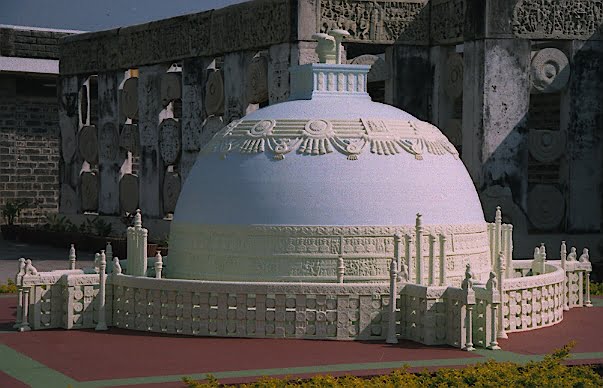The AmaravatiMahacaitya, popularly known as the great stupa at Amaravathi, is a ruined Buddhist monument located at Amaravathi village. The site is under the protection of the Archaeological Survey of India. The campus includes the stupa itself and the Archaeological Museum. The important sculptures from the site are now deposited in a number of museums in India and abroad.
Shrine’s History
The mahacetiya was probably founded in the third century BCE in the time of Asoka but there is no decisive evidence for the foundation.The earliest inscription from the site belongs to the early centuries BCE but it cannot be assign to Asoka with certainty. The main construction phases of Amaravati fall in two main periods, with the additions consisting of railings and carved slabs placed against the stupa proper. These slabs are usually called ‘drum slabs’ because they were placed round the base of the stupa which has a shape similar to a circular drum. In the early period , the stupa had a simple railing consisting of granite pillars, with plain cross-bars, and coping stones. The coping stones with youths and animal reliefs, the early drum slabs, and some other early fragments belong to this period. The stūpa must have been fairly large at this time, considering the size of the granite pillars. The late period of construction started around ca. 50 BCE and continued until circa 250 CE. This period is divided this period into three phases by Akira Shimada on the basis of the dates that can be assigned to parts of the great limestone railing. The first phase is 50-0 CE, and the same period as the Sanchi stūpa I gateways. The second phase is 50-100 CE, the same period as Karli caitya and the Pandavleni Caves at Nasik. The third phase is circa 200-250 CE based on comparisons with Nagarjunakonda sculpture. Some other types of sculpture of belong to an even later time, about the seventh or eighth centuries, and include standing Bodhisattvas and goddesses. Amaravātī continued to be active after this time, probably to about the thirteenth century.
Architectural Relevance of This Shrine
The region between the Krishna and Godavari rivers was an important place for Buddhism from the 2nd century BCE onwards. A Buddhist stupa was built during the reign of Ashoka in 200 BCE, was carved with panels that tell the story of Buddha. The story of the sculpture, including their discovery, misuse and destruction and subsequent preservation & distribution to various museums has been poignantly described by Shimada. During the period of the decline of Buddhism, this stupa was neglected and was buried under rubble. A 14th-century inscription in Sri Lanka mentions repairs made to the stupa, and after that it was forgotten. The stupa is related to the Vajrayana teachings of Kalachakra, still practiced today in Tibetan Buddhism. Dalai Lama of Tibet conducted a Kalachakra initiation at this location in 2006. Art historians regard the art of Amaravati as one of the three major styles or schools of ancient Indian art, the other two being the Mathura style, and the Gandharan style. The Amravati school of art had great influence on art in Sri Lanka and South-East Asia as products from here were carried to those countries. It also had influence over South Indian sculpture. The Chinese traveller and Buddhist monk Hiuen Tsang visited Amaravati in 640 CE, stayed for sometime and studied ‘Abhidhammapitakam’. Xuanzang wrote a glorious account of the place, Viharas and monasteries that existed
Shrine’s Map Location and How to Go There
By Road
The nearest Bus stop is Vijayawada.
By Rail
The Vijayawada Junction is the nearest railway station. Amaravathi comes under the Hyderabad-Vijayawada and Hyderabad-Guntur line.
By Air
The nearest airport is Gannavaram, Vijayawada
